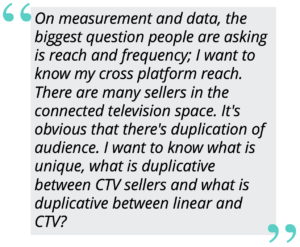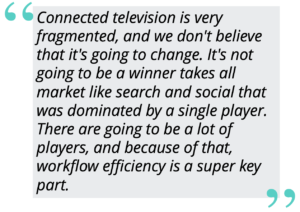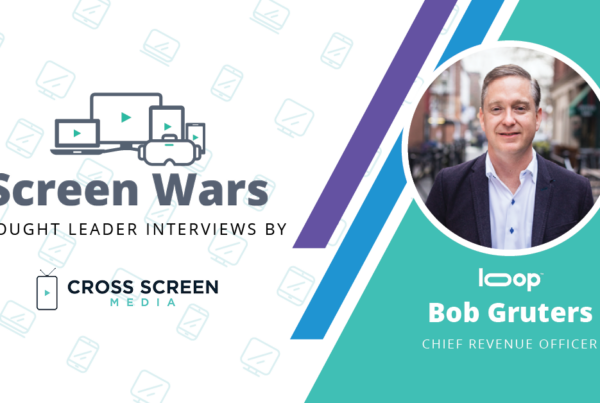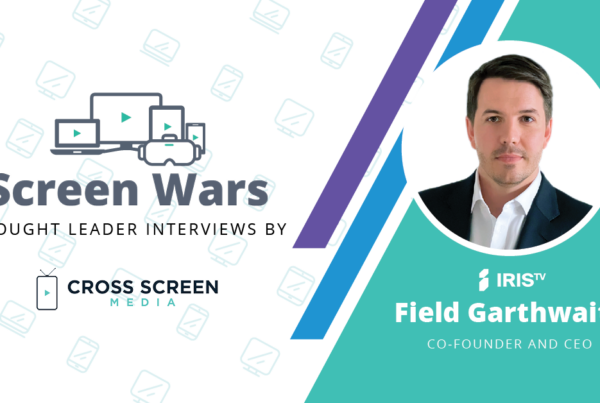Innovid CTO and Co-Founder Tal Chalozin joins Cross Screen Media CEO Michael Beach to share his data-driven perspective on opportunities for agencies, networks, and brands across the Convergent TV Space in our latest Screen Wars Thought Leader Interview. Full transcript below.
Michael Beach: Welcome to to another edition of Screen Wars where we interview the leaders in the convergent TV space. Today it’s my pleasure to welcome Tal Chalozin to Screen Wars. Tal is the CTO and co-founder of Innovid, a leader in the connected TV space. Tal’s one of my favorite people in the convergent TV space. We often overlap and speak at the same conferences and I always make it a point to be in the room whenever Tal gives his talk and I walk away with mobile pages full of notes. Thank you for joining us today, Tal.
Tal Chalozin: Thank you and thanks for the kind words. Thanks for having me. You’re setting the bar for the viewers way too high. I’m clearly not going to live up for that dream, but thank you anyhow.
MB: Absolutely. Let’s start off with an easy ice breaker we’ve asked every guest so far. What was your first job and what lessons did you take away from that that have helped you with your career?
TC: I don’t have a lot of job history. I was in the Israeli Air Force for quite some time, eight and a half years or so as a developer in one of the units that writes embedded software and command and control software for planes and helicopters and ammunition. It was an awesome experience. What did I learn from that? I think the biggest lesson is that there’s zero tolerance for bugs in the code. That’s maybe the biggest thing I learned is that you need to test everything and you never deploy anything with errors. It’s jail time if you deploy something with bugs.
MB: A little more serious than what we’re dealing with today.
TC: I have this stupid joke that is not really funny, but in both jobs there was heavy focus on targeting.
MB: How’d you start in the convergent TV space?
TC: We started Innovid with Zvika Netter, Zack Zigdon and myself. We started Innovid back in 2008 with the dream that television must move to the internet. We didn’t know anything about the space let alone the advertising side of things. We didn’t know how to spell CPM or anything along those lines, but that was the time that Hulu was emerging and it was post the YouTube acquisition, and we felt like television must move to that space. With that, there is a lot of spaces that will change specifically the user experience. We believe that people will create new type of content and new type of ads, and there will be better measurement and everything will be on the internet, will be better and more accurate and more connected. We set out on this journey, frankly, to build software that powers better advertising on television when it moves to the web without really knowing what exactly that means. It took a long time for television actually to converge and to move to the internet. That was our mission from the get-go. We started with technology for interactive commercials, moved into different forms of better engagement, then expanded into ad serving and then expanded into measurement and personalization, a lot of different things, but all in and around the same idea.
MB: Before we jump deep into the conversation, do you mind giving our community an idea on where Innovid sits in the convergent TV space?
TC: Of course. We have three parts to our product. One of them, maybe the core would be an ad serving technology focused on the buy-side. We power technology predominantly to media buying agencies, brands, in-house technology and other people who license software. The core is an ad serving technology. We’re very proud to be the largest video ad server right now in the US and in several other countries we operate in. There’s coming on 40% of all US video is being streamed by us and served by us. For the techie side of the audience, we generate the VAST tags and we stream the MP4 file or HLS or whatever that is.
On top of that, there are two other sides of the application. One of them is as we deliver the video, we want to make sure that that payload of the video would be as relevant and as exciting and as interesting as it can be. We have a set of tools, everything from shoppable interactivity all the way down to depersonalization of the video. A marketer can create many versions of the video and then real-time serve the right version to the right person.
And then, on the other side, we have a set of tools on measurement that extracts as much data as possible from every ad we deliver, anything from just delivery, viewability, demographic, data and others, all the way to what we invested a lot in this year is when we get deeper into television is reach and frequency and more things that allow TV buyers to feel more comfortable in the connected television space.
MB: More than a decade in the space, I’m sure that this answer’s changed over time, but at the start, did you see a lot more siloed video buying teams than you see today? What’s the best entry point for your organization?
TC: Of course. It definitely changed. Our story didn’t change a lot, frankly. We stuck to our guns quite a lot, but the environment changed a lot. Online video or digital video back in 2009, give or take, when we did our first integration into a CBS or an MTV video player to serve VAST or VPAID changed a lot to where it is today. To your question about buyers, first of all, yes, it was predominantly only agencies in the beginning. Brands did not really dabble into that type of technology. Video was the ‘red-headed stepchild’ back then. It was mostly bought by or only bought by the digital team. It was almost like a banner extension. The people who buy banners also or buy reach media also buy this new emerging format, which looks like a rich media which is video. It’s changed quite a lot.
In the past couple of years, ever since connected television is growing, it feels and smells a lot more like television. It depends on the agency, but by and large everyone starts a form of convergence from broadcast TV buyers to video buyers. Many agencies already merged completely. This is the one purchase. To be completely honest, it’s very much driven by the sellers as well. More and more sellers during the upfront time don’t sell screen or don’t sell only broadcast like NBC and ABC Unified or another type of product that sells video everywhere. 
That also drives the buyers to say, “I need to buy it holistically.” Operationally, it’s still very separate. This is where we invest a lot of time on the workflow tools to make it easier so it’s not as siloed, but it is. Frankly, it’s very siloed on the operation. To run a campaign from a buy-side, it’s still fairly siloed.
MB: Absolutely. A lot of progress there, but still plenty ahead. Back a few months ago, Innovid launched Innovid IQ. I think it’s a must-see for trends, and especially by screen and by industry. Tell our audience a little bit more about that along with an interesting data point you’ve come across recently.
TC: Sure. First of all, we deliver so many ads and we always got a lot of questions, anything from media buyers, brands, TV networks, any other vendors in the space all the way to Wall Street analysts and other people that are interested in trends in this space. We always get a lot of questions. We used to release quarterly reports, but in mid-March as the shelter in place started, it was obvious that we needed a lot more heartbeat level data. There’s so many people that are interested in that so we got a lot of questions.
We decided, all kudos to our marketing team that packaged all of this data in this tool that you’re super kind to mention our Innovid IQ. Stephanie Geno our head of marketing is spearheading this product, which right now is updated on a weekly basis. There are two sides of the house. We talk a lot about the specific vertical of marketers and how do they change on a week over week basis or year over year basis. At the beginning, it was very apparent that we had big, lower numbers from automotive, from entertainment, from travel advertisers. Then, what we’ve seen is a big comeback. There are many verticals that came back very quickly into the marketplace, specifically I must call out CPG insurance and pharma as maybe the largest verticals that not only came back into the marketplace, but also are doubling down on it, some of those verticals all the way to doubling year over year right now in spend. And we see that every week. You can go to Innovid IQ to see the exact numbers, but even last week, every week we see those verticals up, but CPG and pharma are the largest increase at 106% or 120% year over year growth just this week. This is followed by a lot of other weeks of increases. This is about the vertical, but another thing that people are very interested about is just the growth of CTV. I’ll give you a high level numbers of overall Innovid to give context. The data that I’m sharing are constant advertiser basis, just to create an even playing field. In Q1, we were flat to low single digit up year-over-year. April was down, but then we’ve seen a recovery in May and definitely in June. We were up low single digits, about three to four digits overall Innovid numbers. And then Q3, specifically July and August were up 25% in September. So far it’s up even more than that on, again, a year over year basis.
This is overall Innovid across every screen, across every advertiser, every type of media. If you just look at CTV, the numbers are a lot more exciting. Even as harsh as Q2 was, we’ve seen 39% year-over-year growth of CTV so comparing CTV ads in Q2, 2019 to Q2, 2020, and this is by volume, everyone asks us those numbers. This is not spend, not CPM, not avails, not viewership, not streams. This is actual ad served on an impression basis. We’re up 39% and July and August is already up 54% year-over-year, and first half of September we’re over 60% year-over-year growth on CTV. CTV is definitely leading the charge of the year over year growth and it’s an amazing engine that not only is growing super fast, but even accelerating the speed of growth.
MB: That’s incredible. We’ve been both involved in the digital transformation of media for a while. A common conversation I know that I’m having is that in the last six months we’ve basically seen five to ten years of transformation packed into a short period. Do you agree with that? If yes, do you see that being the new normal?
TC: 100%. I’ll give you a little bit of a long answer. We started our journey in CTV in 2013. We signed the first deal with Roku back when no one actually knew what Roku is. The numbers were very, very small back then. You’re right. Maybe the big step function started maybe 18 months ago where connected television was not this rounding error but something people started to pay attention, but 100% this year, this is the biggest thing that happened since March and all of 2020 is the increase of CTV. Just to give you a number average across all of Innovid, CTV is roughly 40% of all of traffic that we deliver in the United States. This is including Facebook video, including Snapchat video, including a lot of other things that don’t even play in connected television, and this is 40% of everything we have. This is across all marketers. That’s the average number. We see some marketers that this is roughly 50% of their overall volume, and because CPMs on CTV by and large are even larger, that means that this is 55% to 60% of overall spend on a dollar basis. This is definitely something that it’s not a ‘red-headed stepchild’, not a rounding error, but it becomes the core of what you do. Everything else are the other things.
Definitely, that’s the new normal. We’ve seen a spike in more Roku devices, more Apple TV devices, more Amazon Fire devices unlocked just in sheer app device IDs that we see in the space. No one is going to send them back. Even if I lowered my cable, disconnect from cable or lower my viewership on traditional TV because sports were out of the ecosystem, even when sports is back right now, streaming is stronger than ever. This is definitely not going back.
MB: Obviously, we’re undergoing a massive transformation in consumption. The overall video ad marketplace sees a disruption from the pandemic in terms of industries and where spend is heading. What are a couple of key areas where Innovid is reacting to this and built for the future? 
TC: A lot of things. Maybe I’ll try to summarize it into two parts. One is around measurement and data. The other one is around workflows. On measurement and data, the biggest question people are asking is reach and frequency, I want to know my cross platform reach. There are many sellers in the connected television space. It’s obvious that there’s duplication of audience. I want to know what is unique, what is duplicative between CTV sellers and what is duplicative between linear and CTV? That’s a very, very common question. During COVID, during the shelter in place, another question that was added around measurement is more cost-based attribution, so an actual return on ad spend. More and more marketers are saying, “I don’t care about cost per point. I don’t care about completion rate or viewability or things like that that are crazy proxies. I want to know how many dollars drove an add to cart, how many dollars drove an app download, how many dollars drove an actual purchase or things like that.” We see that even for a non-common like QSR restaurants, McDonald’s, Burger King, Pizza Hut and other vendors like that that are now relying a lot on delivery or driving, are focusing so much more on attribution and hardcore numbers. This is one part that is a big focus.
The other one is that connected television is very fragmented, and we don’t believe that it’s going to change. It’s not going to be a winner takes all market like search and social that was dominated by a single player. There are going to be a lot of players, and because of that workflow efficiency is a super key part. If you want to build a big nationwide reach, you need to buy media from Peacock, you need to buy media from YouTube, from Hulu and use DSPs and other parts. It needs to be seamless and efficient, otherwise you increase your costs significantly. 
This is an area we invest a lot because quality needs to be extremely high. No one is willing to compromise quality on this workflow part specifically when guys like Peacock come into the ecosystem. Shameless plug; starting on October 1st, Peacock is going to allow VAST ad serving, which means that you can now actually do third party ad serving. We worked very closely with that team to make sure that workflow efficiency doesn’t contradict quality. We still can employ the extremely high quality that television service require, but make it super efficient, but more to come on that part. This is a long answer, but those are the big things that people are asking and where we’re investing time.
MB: That’s very exciting. Looking ahead, what’s the one potential development in the convergent TV space that you’re most excited about?
TC: So many things. To be completely frank, we service agencies, we service marketers, but we think all the time this is where we started and it’s been our lighthouse all along – our focus is about the viewer. It’s still the case that if I am a viewer of the streaming world, all my friends think that we single-handedly are the ones in charge of making sure that they’re not going to be seeing the same ads all the time. I’m sure you’re getting it the same from your wife or from your friends all the time, “Why do I see the same ads all the time? Why do I see a bad ad? Why is the quality not as good? I’m not buying a car or don’t have kids – why do I see diaper ads?”
I think that this is the real thing that we need to solve. We take responsibility for that. Again, we clearly have only a small sliver of that, but as a pretty big player in the space I think we’re responsible for making an impact. That’s an area where we are focusing. I think our job here will be done when the experience of viewing ads on ad-supported television will be amazing. I always look at Instagram as a pretty good experience for the one reason that it’s not that I’m forced to watch it, it’s actually the other way around. I’m scrolling with my finger and I’m stopping to watch ads. It’s a complete reverse model. I like skateboarding so when I’m seeing a skateboarding ad, I’m actually stopping to watch that because this is the best blur between content and ads that it could be. This should be the same experience in television, that people are not forced to watch it, they actually want to watch it. That’s the thing that we need to improve.
MB: Absolutely. One more question – in the current environment, if you could get your entire team to read one book, what would that book be?
TC: The book I recommend is Shoshana Zuboff’s Surveillance Capitalism. It’s a book which is clearly to the extreme, but we’re paying a lot of attention to the world of identity and the world of data tracking. Internet advertising overall was built on a tracking-by-default type of mentality. I think that television or the second act of advertising when it comes to television needs to be built as privacy-by-default. First and foremost, the world is private and you collect only the things that you are allowed to, and only the things that you actually need to do your job and not the other way around. It’s not that this book is the end-all be-all, and there’s many things that I do not agree with, but I think it definitely opens people’s eyes and ears to what’s actually happening in the surveillance economy.
MB: That’s a great book. Tal, I’m grateful for your time. I know our community is going to find this extremely valuable and I’m sure will have follow-up questions. We’ll put all the links to everything in the newsletter. Again, I want to send you our best thanks here.
TC: Of course. Thank you so much. Thank you, Michael. Thanks Cross Screen Media, and super excited to be here. Thank you.
See the rest of the Screen Wars Thought Leader Interview series here!
Tal Chalozin is co-founder and CTO of Innovid, the leading connected TV and video advertising platform for advertisers to engage consumers across all screens and channels. Tal leads Innovid’s long-term technology vision, global product creation and implementation, and business development efforts, as well as identifying and developing emerging trends and opportunities for product innovation and digital TV/OTT collaborations. He has forged partnerships with Facebook, Snapchat, Twitter, Samsung, Roku and Hulu, amongst others, to help advertisers bring interactive video to viewers everywhere.
Tal is a serial entrepreneur and tireless global leader in video technology. In addition to serving as Innovid’s CTO, Tal is a board member for the IAB’s Digital Video Center of Excellence and for the National Academy of Television Arts and Sciences. He has been named a 2018 inductee in the American Advertising Federation’s Advertising Hall of Achievement for his significant impact on the industry via mentorship, inspiration, volunteerism and training. Previous accolades include being named a “Technology Pioneer” by the World Economic Forum, one of the “Best Young European Entrepreneurs” by Businessweek, a member of Multichannel News’ “40 Under 40” Class of 2016, and to Cynopsis Digital’s 2016 “It List.”
Prior to Innovid, Tal co-founded GarageGeeks – a non-profit organization and one of Israel’s largest hacker spaces and innovation hubs boasting more than 8,000 members. Tal also served as an officer in an elite computer unit in the Israeli Air Force for over eight years where he led the development of several military products with high algorithmic complexity.
Tal owns several global patents in digital video technology, and he is a regular speaker at global events, including Cannes Lion, CES, The Drum’s Programmatic Punch, IAB, MWC, NAB, TVOT, AdExchanger’s Programmatic I/O, Broadcasting & Cable’s Advanced TV, Wired Magazine’s NEXTFEST, Le Web’s Digital Innovation Conference, Ars Electronica, and eConsultancy’s Creative Programmatic.
Cross Screen Media is a marketing analytics and software company empowering marketers to plan, activate, and measure Connected TV and audience-driven Linear TV advertising at the local level. Our closed-loop solutions help brands, agencies, and networks succeed in the Convergent TV space. For more information, visit CrossScreenMedia.com.




